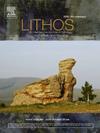Contribution of alkaline magmas to the petrogenesis of Triassic aluminous A-type granites on Liaodong Peninsula, Northeastern China
IF 2.9
2区 地球科学
Q2 GEOCHEMISTRY & GEOPHYSICS
引用次数: 0
Abstract
Aluminous A-type granites are not typically associated with mantle-derived rocks. Their generation is usually linked to crustal melting with mantle-derived magmas primarily acting as a heat source. However, the Triassic Bolinchuan A-type granites on Liaodong Peninsula, northeastern China, coexist with a large mantle-derived alkaline igneous complex, indicating a close genetic relationship that provides new insights into the petrogenesis of aluminous A-type granites. The Bolinchuan granites were formed during 230–226 Ma, coeval with syenites in the alkaline complex (230–224 Ma). The granites are metaluminous to weakly peraluminous, but have relatively high alkali contents (8.61–9.40 wt%). Their high Ga/Al ratios, elevated Nb, Zr, Ce, and Y contents, and high magmatic temperatures (>875 °C) indicate an affinity with aluminous A-type granites. However, the Bolinchuan granites have relatively high MgO contents at intermediate SiO2 contents, with Mg# values of up to 47; these features are inconsistent with the melting of only crustal rocks. Instead, these granites contain mineral phases similar to those of the syenites and exhibit major and trace element trends that are continuous with those of the syenites. Their geochemical features include enrichments in large-ion lithophile elements (e.g., Ba and Sr), depletions in high-field-strength elements (e.g., Nb and Ta) and heavy rare earth elements, and small negative Eu anomalies, which are also consistent with the features of the associated syenites. Furthermore, the granites and their accessory minerals have high initial 87Sr/86Sr ratios, and low εNd(t) and εHf(t) values, which are similar to the syenites, apart from being slightly less isotopically enriched. These geochemical and isotopic features suggest the Bolinchuan granites formed from the syenitic magmas by fractional crystallization of alkali feldspar, amphibole, and apatite, in combination with the addition of ∼30 % juvenile crust-derived materials, as indicated by modeling. Our study reveals that differentiation of mantle-derived alkaline magmas can generate magmas parental to aluminous A-type granites. As such, the mantle not only provides the heat for the formation of aluminous A-type granites, but can also be the main source of the magmas.
碱性岩浆对中国东北辽东半岛三叠纪A型铝质花岗岩成岩作用的贡献
铝质A型花岗岩通常与地幔衍生岩无关。它们的生成通常与地壳熔融有关,而地幔岩浆则是主要的热源。然而,位于中国东北辽东半岛的三叠纪博林川A型花岗岩与一个大型地幔源碱性火成岩复合体共存,表明两者之间存在密切的遗传关系,这为铝质A型花岗岩的岩石成因提供了新的见解。博林川花岗岩形成于230-226Ma期间,与碱性复合体中的正长岩(230-224Ma)共生。花岗岩为金属铝质至弱过铝质,但碱含量相对较高(8.61-9.40 wt%)。这些花岗岩的镓/铝比率高,铌、锆、铈和钇含量高,岩浆温度高(875 °C),表明它们与铝质 A 型花岗岩有亲缘关系。然而,波林川花岗岩在二氧化硅含量中等的情况下,氧化镁含量相对较高,Mg#值高达47;这些特征与仅熔融地壳岩石的情况不符。相反,这些花岗岩含有与正长岩相似的矿物相,并表现出与正长岩连续的主要元素和微量元素趋势。它们的地球化学特征包括大离子亲岩元素(如 Ba 和 Sr)的富集、高场强元素(如 Nb 和 Ta)和重稀土元素的贫化,以及小的负 Eu 异常,这与相关正长岩的特征也是一致的。此外,花岗岩及其附属矿物的初始 87Sr/86Sr 比值较高,εNd(t) 和 εHf(t)值较低,除了同位素富集程度稍低外,与正长岩相似。这些地球化学和同位素特征表明,博林川花岗岩是由正长岩岩浆经碱性长石、闪长石和磷灰石的分块结晶形成的,同时还加入了30%的幼壳衍生物质。我们的研究揭示了地幔衍生碱性岩浆的分化可生成铝质A型花岗岩的母岩。因此,地幔不仅为A型铝质花岗岩的形成提供热量,而且也可能是岩浆的主要来源。
本文章由计算机程序翻译,如有差异,请以英文原文为准。
求助全文
约1分钟内获得全文
求助全文
来源期刊

Lithos
地学-地球化学与地球物理
CiteScore
6.80
自引率
11.40%
发文量
286
审稿时长
3.5 months
期刊介绍:
Lithos publishes original research papers on the petrology, geochemistry and petrogenesis of igneous and metamorphic rocks. Papers on mineralogy/mineral physics related to petrology and petrogenetic problems are also welcomed.
 求助内容:
求助内容: 应助结果提醒方式:
应助结果提醒方式:


